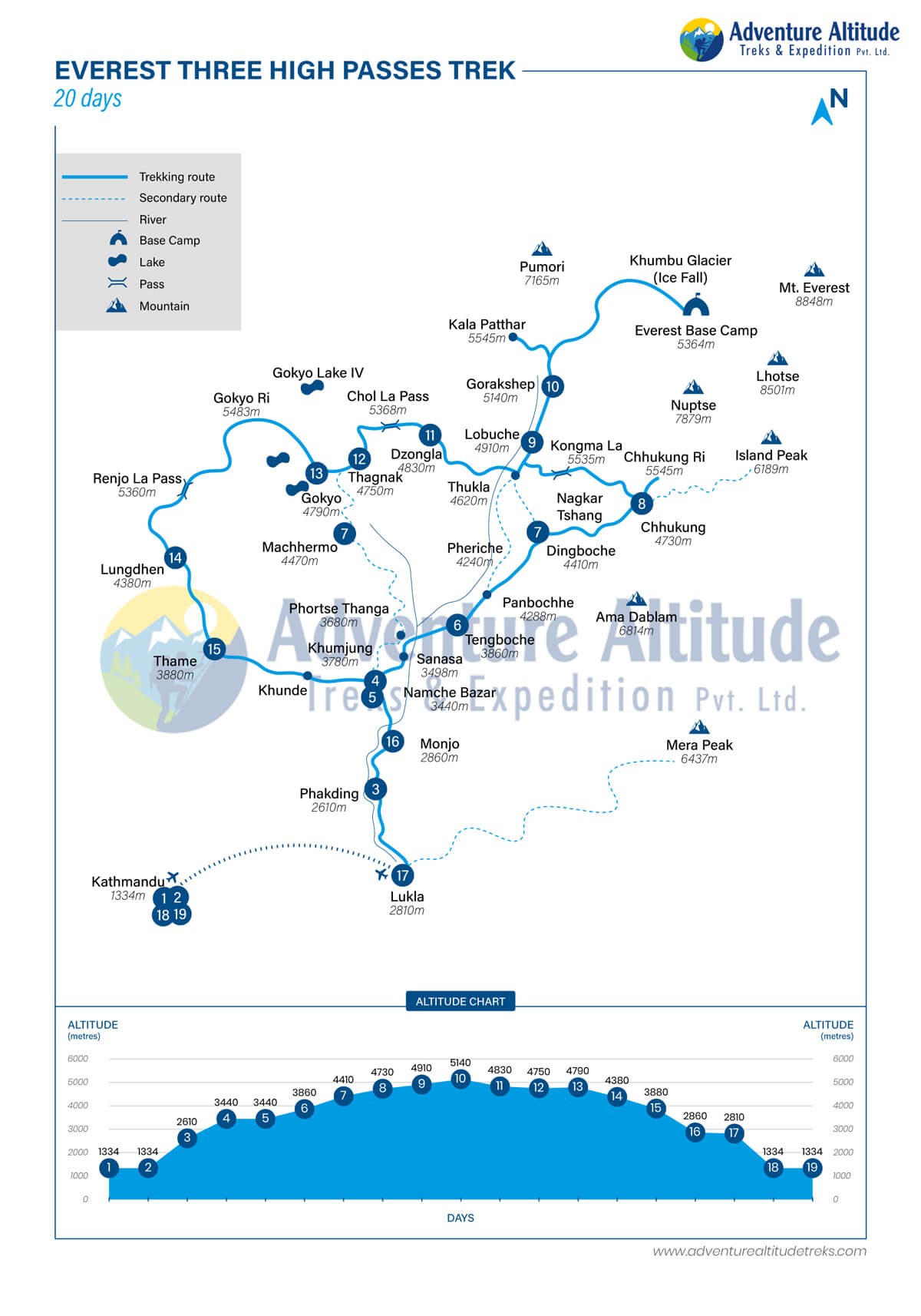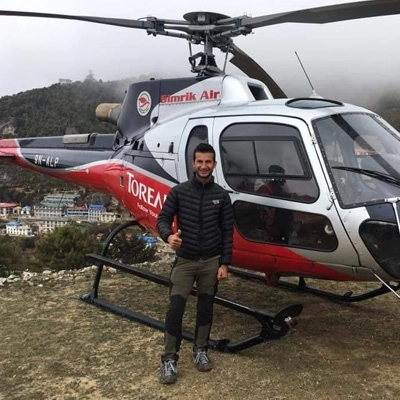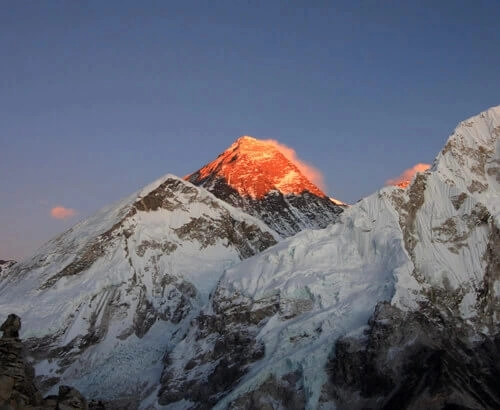Everest Three High Pass Trek
Everest Three High Passes Trekking is a great adventure that leads you to experience high altitude traverse to enter from one scenic valley to another within the shade and harmony of high mountains with breathtaking scenery to enjoy. This trail offers the ultimate and complete trekking experience of the Khumbu region that connects three high passes linked with 4 distinct valleys of Bhotekoshi, Gokyo, Imja Tse, and Khumbu and also gives you a chance to trek to Everest Base Camp. This trek completes with the crossing of three passes Renjo La (5,388 m), Cho La (5,380 m), and Kongma La (5,535 m) along with including Everest Base Camp. What makes this trek unforgettable and incomparable is the climbing of three peaks of Gokyo Ri (5,483 m), Kala Patthar(5,545 m), and Chukung (5,550 m) without needing any climbing experience.
The Three Passes Trek is situated in the Everest Region or commonly called the Khumbu region of Nepal. The journey to the most challenging and most rewarding trek begins with a flight from Kathmandu to Lukla from where the actual trek begins. Alternate to taking a flight, you can take a bus up to Jiri and start to trek which is another experience itself. Starting from Jiri, you trek through the Solu Khumbu Valley up to Lukla before joining the main trail. This will add extra 6 days to your whole trek.
Everest Three High Passes Trekking is adventurous and challenging in snow conditions. This will be the toughest walk, where our expert guides will take care of our clients with great precaution. This trail is suitable for strong and expert trekkers and adventurers who have done immense high-altitude walks in Himalayan countries and know the areas when tough days are ahead, but any interested trekkers can also join in this awesome adventure, as our itinerary days are much more flexible with rooms for acclimatization and rest.
Everest Three High Passes Trekking offers superb views of Mt. Everest (8,848 m / 29, 028ft) Lhotse (8,516 m-24,940 ft), Nuptse (7,855 m-25,772 ft) and Lho - La or Khumbutse peak (6,036 m - 19,992ft) Mt. Lingtren (6,749 m / 22,142 ft) Chnagtse (7,583 m / 25,230 ft) Mt. Pumori (7,161 m / 25,772 ft) Ama Dablam ( 6,812 m / 22,480 ft) Kangtenga (6,782 m / 22, 380 ft) Tharmarserku ( 6,623 m / 21, 855 ft) Kwangde (6,011 m / 19,837 ft) Kusum Kanguru (6,373 m / 21,030 ft) holy peak of Khumbu-la (5,761 m / 19,012 ft) and as far towards world’s 5th highest Mt. Makalu (8,463 m / 27, 766 ft) with trekking peaks Island Peak / Imjatse (6,160 m / 20,328ft) Lobuche Peak (6,119 m / 20,192 ft) Pokhalde (5,806 m / 19,159 ft) and many other smaller unnamed peaks with world 6th highest Cho-Oyu 8,201 m high.
The specialty of Three High Passes Trek with Everest Base Camp:
The trek to the Everest region is always special. Imagine being at the bottom of the world's highest Peak, the thrilling adventure, the terrain that varies from green lush forest to rugged, the massive mountain peaks, trekking through Sagarmatha National Park that houses much rare and endangered flora and fauna, the amazing adventure of landing at one of the world's dangerous airport, passing through ancient trade route at 5000 m above altitude. This trek provides an ultimate and lifetime adventure for those who are willing to accept the challenge.
Difficulty grade:
This trail is considered extreme as trekkers have to walk through the rugged terrain at high altitudes for a minimum of 7-8 hours/day. Trekking in the Himalayas is always challenging, but this trail has surpassed all the other trails in terms of difficulty and extremity. Everest Threepasses trek is suitable for experienced and passionate hikers who can walk at least 7 – 8 hours on rugged mountain terrain. Someday, you might even have to walk for 8 – 9 hours. Waking at an extreme altitude is challenging; however, with excellent health, a positive attitude, and strong determination, you can achieve the trek successfully. We suggest you involve in physical activities like jogging, running, leg exercise, and swimming a few months before the trip. Previous hiking experience would be a great asset without mandatory technical skills are not required.
Meals and accommodations:
This is a high-altitude tea-house trek. So accommodations will be on tea-house or local lodges. Facilities of electricity, internet, and western-style toilet are available in lower regions of the trek. Accommodations in the upper region use solar power for electricity so you may have to pay a small amount for charging your devices and Internet(if available). Meals will be mostly local dishes including lentils, rice, curry, pickles, etc.
Transportation:
Fly to and from Lukla by Plane and option by drive as per your requirement.
Best season for Everest Three Pass Trek:
Spring (September-November) and autumn (March-May) are the best time of the year for the Everest Three Passes Trek. The weather during this season is excellent, and so are the views. However, these two being the peak season, the trail is crowded with trekkers and tea houses are busy. If you want a little less crowd and are willing to invest a little more in winter gear, then early winter ( December to early January ) will be best. We highly recommend any trekkers avoid the monsoon and mid-winter season to trek Three Passes Trek. During Monsoon, the trails are wet and dangerous and the views are not guaranteed due to clouds. While in Winter, most of the teahouse is closed and some parts of the main trails are closed too so you might need to take a dangerous detour.
Guides and Porters:
The team of Adventure Altitude Treks and Expedition Co. is one of the most experienced, reliable, hospitable, and respected in Nepal. The agency and team members are all affiliated with the Trekking Agency's Association of Nepal (TAAN), the Nepal Mountaineering Association(NMA), the Nepal Tourism Board, the Ministry of Culture, Tourism and Civil Aviation of Nepal, the Sustainable Tourism Network, and Himalayan Rescue Association. We will provide a professional and experienced English-speaking guide with sound knowledge of place and trek. With an experience of more than 10 years in this field, we can guarantee your satisfaction.
If you need a porter, we will provide you with 1 porter/2 guests. The porter will be carrying 25 kg maximum (12 -13 kg per person). You will need to carry your day pack yourselves to keep your personal belongings like wallet, mobile and accessories, cameras and accessories, water bottle, dry snacks, torch/headlights, and other personal belongings. For us, the safety of our clients and members comes first. And it is our collective responsibility to ensure the safety and security of porters, guides, and guests. You can help to bring safety to our team members by taking only those things which are necessary. We will always be thankful for your acknowledgment.
Everest Three High Pass Trek Permit and Rules
For Everest Three High Pass Trek, you will need TIMS (10 US$) and Sagarmatha National Park (30 US$) entrance permit. The local Government charge of 2000 NPR should be paid while entering Pasang Lhamu V.D.C.
The Local Government strictly follows a clean environment policy which requires travelers to use a bin or to carry it with them until an appropriate place is found.
Local restaurant rules and regulations are to be followed.




